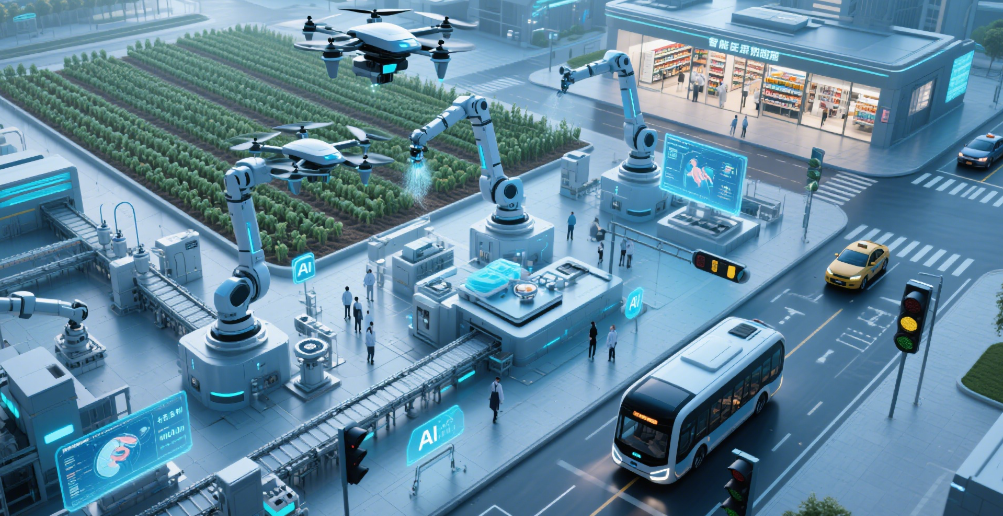Artificial Intelligence and Geography: Shaping the Future of Spatial Understanding
观棋 2025-06-20
In the era of rapid technological advancement, the integration of Artificial Intelligence (AI) with geography is revolutionizing how we perceive, analyze, and interact with our physical world. This interdisciplinary fusion is not only enhancing traditional geographic studies but also opening up new frontiers in spatial analysis, environmental management, and urban planning. By leveraging AI’s capabilities in data processing, pattern recognition, and predictive modeling, geographers and researchers are able to tackle complex spatial challenges with unprecedented accuracy and efficiency.
Artificial Intelligence and Geography: Shaping the Future of Spatial Understanding
In the era of rapid technological advancement, the integration of Artificial Intelligence (AI) with geography is revolutionizing how we perceive, analyze, and interact with our physical world. This interdisciplinary fusion is not only enhancing traditional geographic studies but also opening up new frontiers in spatial analysis, environmental management, and urban planning. By leveraging AI’s capabilities in data processing, pattern recognition, and predictive modeling, geographers and researchers are able to tackle complex spatial challenges with unprecedented accuracy and efficiency.
The Synergy Between AI and Geographic Information Systems (GIS)
Geographic Information Systems (GIS) have long been the cornerstone of spatial data analysis, allowing researchers to capture, store, and visualize geographic information. However, the advent of AI has significantly augmented GIS capabilities, enabling it to handle big data volumes and derive deeper insights from complex datasets. Machine learning algorithms, for instance, can process vast amounts of geospatial data from various sources such as satellite imagery, aerial photographs, and sensor networks, identifying patterns and trends that might be imperceptible to human analysts.
One prominent application lies in the field of remote sensing. AI-powered image recognition techniques can automatically classify land use and land cover types from high-resolution satellite images, distinguishing between forests, urban areas, water bodies, and agricultural lands with remarkable precision. This not only saves significant time and effort compared to manual interpretation but also allows for more frequent and consistent monitoring of environmental changes. For example, researchers have used convolutional neural networks (CNNs) to detect deforestation in tropical regions, enabling timely interventions to combat illegal logging and forest degradation.
AI in Environmental Monitoring and Climate Change Research
The impact of AI on geographic research is particularly evident in environmental monitoring and climate change studies. Geographers are using AI models to analyze spatial patterns of climate variables, predict weather events, and assess the impacts of climate change on ecosystems and human settlements. Machine learning algorithms can process historical climate data, combined with spatial factors such as topography and land use, to generate accurate climate projections for specific regions.
In coastal areas, AI-driven models are being used to predict sea-level rise and storm surges, helping communities develop effective adaptation strategies. These models take into account various factors, including global climate patterns, local topography, and human-induced changes in the landscape, to provide detailed risk assessments. Similarly, in the study of natural disasters such as earthquakes and floods, AI algorithms can analyze spatial data on fault lines, river networks, and population density to identify high-risk areas and optimize emergency response strategies.
Urban Planning and Smart Cities
The integration of AI and geography is also transforming urban planning and the development of smart cities. By analyzing large datasets on population distribution, traffic patterns, energy consumption, and infrastructure usage, AI systems can help urban planners make data-driven decisions to create more sustainable and livable cities.
For instance, AI-powered traffic management systems can analyze real-time traffic data from sensors and cameras to predict congestion hotspots and optimize traffic light timings, reducing travel times and emissions. In addition, machine learning models can be used to simulate the impacts of urban development projects on traffic flow, air quality, and public transportation accessibility, allowing planners to evaluate different scenarios and choose the most optimal solution.
Another exciting application is in the field of urban vegetation planning. AI algorithms can analyze spatial data on sunlight exposure, soil quality, and water availability to recommend the most suitable locations for planting trees and green spaces, enhancing urban biodiversity and mitigating the urban heat island effect.
Challenges and Ethical Considerations
While the integration of AI and geography offers numerous benefits, it also presents several challenges and ethical considerations. One of the main challenges is the quality and availability of geospatial data. AI models rely heavily on large, diverse, and accurate datasets, but in many regions, especially developing countries, such data may be scarce, outdated, or inaccessible. Ensuring equitable access to geospatial data and promoting data sharing initiatives are crucial for maximizing the benefits of AI in geography.
Ethical concerns also arise regarding the use of AI in spatial analysis, particularly in areas such as surveillance and privacy. The collection and analysis of geospatial data from smartphones, social media, and other digital platforms can potentially infringe on individual privacy if not properly regulated. It is essential to establish clear ethical guidelines and legal frameworks to govern the use of AI in geographic research and applications, ensuring that privacy rights are protected and data is used responsibly.
The Future of AI in Geography
Looking ahead, the future of AI in geography is promising, with ongoing advancements in machine learning, deep learning, and big data analytics expected to further enhance our understanding of spatial processes and phenomena. The development of more sophisticated AI models that can handle unstructured geospatial data, such as text from social media posts and images from drones, will open up new avenues for research and application.
Additionally, the integration of AI with emerging technologies such as the Internet of Things (IoT) and blockchain holds great potential for improving the accuracy and transparency of geospatial data collection and management. IoT sensors can provide real-time data on various environmental and urban parameters, which can be fed into AI models for immediate analysis and decision-making. Blockchain technology, on the other hand, can ensure the integrity and traceability of geospatial data, making it more reliable and trustworthy.
In conclusion, the convergence of AI and geography is reshaping the way we understand and interact with our physical environment. From enhancing environmental monitoring and urban planning to supporting climate change mitigation and adaptation, AI is proving to be a powerful tool in addressing some of the most pressing spatial challenges of our time. As technology continues to advance, it is essential for geographers, data scientists, and policymakers to work together to harness the full potential of AI while addressing the associated challenges and ethical considerations. By doing so, we can create a more sustainable, resilient, and inclusive future for our planet.
In the era of rapid technological advancement, the integration of Artificial Intelligence (AI) with geography is revolutionizing how we perceive, analyze, and interact with our physical world. This interdisciplinary fusion is not only enhancing traditional geographic studies but also opening up new frontiers in spatial analysis, environmental management, and urban planning. By leveraging AI’s capabilities in data processing, pattern recognition, and predictive modeling, geographers and researchers are able to tackle complex spatial challenges with unprecedented accuracy and efficiency.
The Synergy Between AI and Geographic Information Systems (GIS)
Geographic Information Systems (GIS) have long been the cornerstone of spatial data analysis, allowing researchers to capture, store, and visualize geographic information. However, the advent of AI has significantly augmented GIS capabilities, enabling it to handle big data volumes and derive deeper insights from complex datasets. Machine learning algorithms, for instance, can process vast amounts of geospatial data from various sources such as satellite imagery, aerial photographs, and sensor networks, identifying patterns and trends that might be imperceptible to human analysts.
One prominent application lies in the field of remote sensing. AI-powered image recognition techniques can automatically classify land use and land cover types from high-resolution satellite images, distinguishing between forests, urban areas, water bodies, and agricultural lands with remarkable precision. This not only saves significant time and effort compared to manual interpretation but also allows for more frequent and consistent monitoring of environmental changes. For example, researchers have used convolutional neural networks (CNNs) to detect deforestation in tropical regions, enabling timely interventions to combat illegal logging and forest degradation.
AI in Environmental Monitoring and Climate Change Research
The impact of AI on geographic research is particularly evident in environmental monitoring and climate change studies. Geographers are using AI models to analyze spatial patterns of climate variables, predict weather events, and assess the impacts of climate change on ecosystems and human settlements. Machine learning algorithms can process historical climate data, combined with spatial factors such as topography and land use, to generate accurate climate projections for specific regions.
In coastal areas, AI-driven models are being used to predict sea-level rise and storm surges, helping communities develop effective adaptation strategies. These models take into account various factors, including global climate patterns, local topography, and human-induced changes in the landscape, to provide detailed risk assessments. Similarly, in the study of natural disasters such as earthquakes and floods, AI algorithms can analyze spatial data on fault lines, river networks, and population density to identify high-risk areas and optimize emergency response strategies.
Urban Planning and Smart Cities
The integration of AI and geography is also transforming urban planning and the development of smart cities. By analyzing large datasets on population distribution, traffic patterns, energy consumption, and infrastructure usage, AI systems can help urban planners make data-driven decisions to create more sustainable and livable cities.
For instance, AI-powered traffic management systems can analyze real-time traffic data from sensors and cameras to predict congestion hotspots and optimize traffic light timings, reducing travel times and emissions. In addition, machine learning models can be used to simulate the impacts of urban development projects on traffic flow, air quality, and public transportation accessibility, allowing planners to evaluate different scenarios and choose the most optimal solution.
Another exciting application is in the field of urban vegetation planning. AI algorithms can analyze spatial data on sunlight exposure, soil quality, and water availability to recommend the most suitable locations for planting trees and green spaces, enhancing urban biodiversity and mitigating the urban heat island effect.
Challenges and Ethical Considerations
While the integration of AI and geography offers numerous benefits, it also presents several challenges and ethical considerations. One of the main challenges is the quality and availability of geospatial data. AI models rely heavily on large, diverse, and accurate datasets, but in many regions, especially developing countries, such data may be scarce, outdated, or inaccessible. Ensuring equitable access to geospatial data and promoting data sharing initiatives are crucial for maximizing the benefits of AI in geography.
Ethical concerns also arise regarding the use of AI in spatial analysis, particularly in areas such as surveillance and privacy. The collection and analysis of geospatial data from smartphones, social media, and other digital platforms can potentially infringe on individual privacy if not properly regulated. It is essential to establish clear ethical guidelines and legal frameworks to govern the use of AI in geographic research and applications, ensuring that privacy rights are protected and data is used responsibly.
The Future of AI in Geography
Looking ahead, the future of AI in geography is promising, with ongoing advancements in machine learning, deep learning, and big data analytics expected to further enhance our understanding of spatial processes and phenomena. The development of more sophisticated AI models that can handle unstructured geospatial data, such as text from social media posts and images from drones, will open up new avenues for research and application.
Additionally, the integration of AI with emerging technologies such as the Internet of Things (IoT) and blockchain holds great potential for improving the accuracy and transparency of geospatial data collection and management. IoT sensors can provide real-time data on various environmental and urban parameters, which can be fed into AI models for immediate analysis and decision-making. Blockchain technology, on the other hand, can ensure the integrity and traceability of geospatial data, making it more reliable and trustworthy.
In conclusion, the convergence of AI and geography is reshaping the way we understand and interact with our physical environment. From enhancing environmental monitoring and urban planning to supporting climate change mitigation and adaptation, AI is proving to be a powerful tool in addressing some of the most pressing spatial challenges of our time. As technology continues to advance, it is essential for geographers, data scientists, and policymakers to work together to harness the full potential of AI while addressing the associated challenges and ethical considerations. By doing so, we can create a more sustainable, resilient, and inclusive future for our planet.












